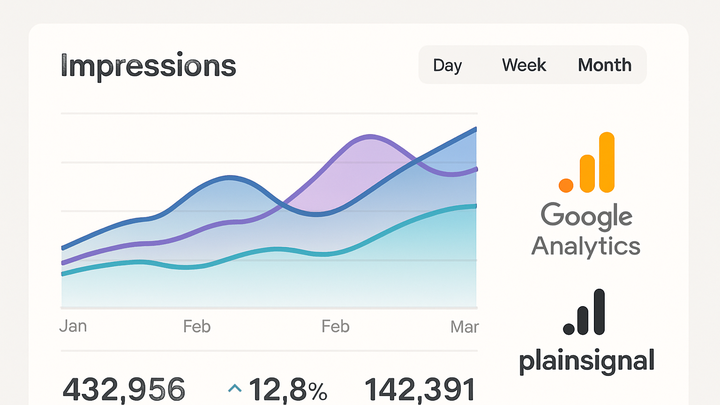Published on 2025-06-28T00:12:06Z
What are Impressions? Examples and Importance in Analytics
In digital analytics, an Impression represents each instance where a piece of content, ad, or page element is loaded and viewable to a user. It’s one of the fundamental metrics used to gauge visibility and initial exposure, distinct from deeper engagement measures like clicks or conversions. Impressions can be tracked through various mechanisms—such as client-side scripts or server-side events—and are critical for understanding reach, setting advertising benchmarks, and allocating budgets. Different analytics platforms, such as Google Analytics 4 (GA4) and PlainSignal’s cookie-free solution, handle impression tracking in distinct ways, influencing data accuracy and privacy compliance. By mastering how impressions are counted and interpreted, analysts and marketers can optimize their campaigns and make data-driven decisions.
Impressions
Count of how many times content or ads are displayed, indicating reach and visibility.
Importance of Impressions in Analytics
Impressions provide insights into how many times your content, ad, or page is seen. They form the foundation for understanding reach and user exposure across marketing and product channels. Marketers use impression data to benchmark campaign performance, measure brand visibility, and optimize advertising spend. However, impressions alone don’t reflect user engagement; they must be evaluated alongside other metrics to form a complete picture.
-
Performance benchmarks
Impressions help set benchmarks for campaign performance and allow you to compare visibility across different channels or time periods.
-
Budget allocation
Advertising platforms often charge based on CPM (cost per thousand impressions), making accurate impression counts essential for cost management.
-
Audience reach
By analyzing impressions, you can estimate how many users have potentially been exposed to your content, forming the basis for reach metrics.
Tracking Impressions
Most analytics platforms capture impressions through tracking code or pixel requests that fire when a page or specific element loads. Understanding the underlying methods helps diagnose data discrepancies and ensures reliable reporting.
-
Client-side pixel tracking
A small JavaScript snippet or image pixel fires upon page load, sending a request to the analytics server that records an impression.
-
Server-side tracking
Impressions can be recorded on the server when rendering pages or via API calls, reducing reliance on client-side execution and improving data consistency.
-
Cookie-free vs traditional methods
Traditional analytics rely on browser cookies to count sessions and unique users, which can undercount impressions when cookies are blocked or deleted. Cookie-free methods use alternative identifiers like local storage or hashed IPs to ensure consistent counts.
-
Cookie-based tracking
Uses browser cookies to track unique sessions, but may miss impressions if cookies are rejected, cleared, or blocked by privacy settings.
-
Cookie-free tracking
Employs deterministic identifiers or server-side logic (as in PlainSignal) to capture impressions without setting cookies, enhancing privacy compliance.
-
Impressions in GA4 vs PlainSignal
Different analytics tools implement impression counting in unique ways. Below are setup examples for GA4 and PlainSignal, illustrating how each platform tracks impressions on your site.
-
GA4 implementation
Google Analytics 4 uses the gtag.js library to automatically count page_view events as impressions. Here’s a basic setup:
<script async src="https://www.googletagmanager.com/gtag/js?id=YOUR_GA4_MEASUREMENT_ID"></script> <script> window.dataLayer = window.dataLayer || []; function gtag(){dataLayer.push(arguments);} gtag('js', new Date()); gtag('config', 'YOUR_GA4_MEASUREMENT_ID'); </script> -
PlainSignal implementation
PlainSignal provides a lightweight, cookie-free script to capture impressions. Install it by adding the following code to your site:
<link rel="preconnect" href="//eu.plainsignal.com/" crossorigin /> <script defer data-do="yourwebsitedomain.com" data-id="0GQV1xmtzQQ" data-api="//eu.plainsignal.com" src="//cdn.plainsignal.com/plainsignal-min.js"></script>
Interpreting Impressions Data
Raw impression counts are a starting point for measuring visibility but must be contextualized. Apply filters, correlate with engagement metrics, and set realistic benchmarks to derive actionable insights.
-
Filtering bots and invalid traffic
Exclude known bots, spiders, and internal IP addresses to ensure your impression data reflects genuine user views.
-
Combining with other metrics
Pair impressions with clicks, sessions, and conversions to evaluate engagement quality, calculate click-through rates, and optimize campaign strategies.
-
Setting realistic goals
Use historical data to define target impression ranges, adjusting for seasonality, campaign duration, and budget constraints.
